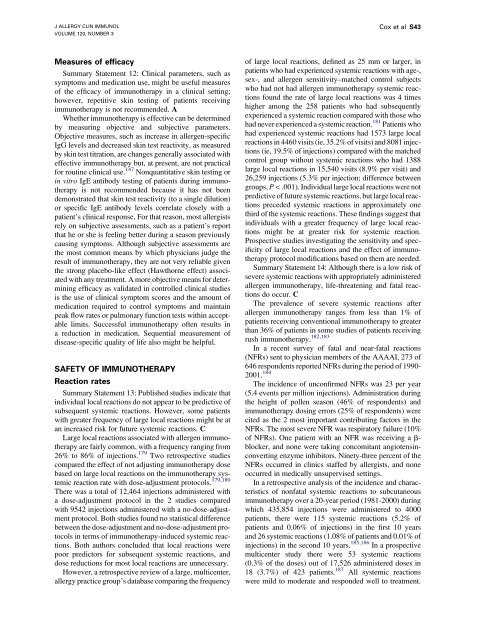Immunotherapy Safety for the Primary Care ... - U.S. Coast Guard
Immunotherapy Safety for the Primary Care ... - U.S. Coast Guard
Immunotherapy Safety for the Primary Care ... - U.S. Coast Guard
You also want an ePaper? Increase the reach of your titles
YUMPU automatically turns print PDFs into web optimized ePapers that Google loves.
J ALLERGY CLIN IMMUNOL<br />
VOLUME 120, NUMBER 3<br />
Cox et al S43<br />
Measures of efficacy<br />
Summary Statement 12: Clinical parameters, such as<br />
symptoms and medication use, might be useful measures<br />
of <strong>the</strong> efficacy of immuno<strong>the</strong>rapy in a clinical setting;<br />
however, repetitive skin testing of patients receiving<br />
immuno<strong>the</strong>rapy is not recommended. A<br />
Whe<strong>the</strong>r immuno<strong>the</strong>rapy is effective can be determined<br />
by measuring objective and subjective parameters.<br />
Objective measures, such as increase in allergen-specific<br />
IgG levels and decreased skin test reactivity, as measured<br />
by skin test titration, are changes generally associated with<br />
effective immuno<strong>the</strong>rapy but, at present, are not practical<br />
<strong>for</strong> routine clinical use. 147 Nonquantitative skin testing or<br />
in vitro IgE antibody testing of patients during immuno<strong>the</strong>rapy<br />
is not recommended because it has not been<br />
demonstrated that skin test reactivity (to a single dilution)<br />
or specific IgE antibody levels correlate closely with a<br />
patient’s clinical response. For that reason, most allergists<br />
rely on subjective assessments, such as a patient’s report<br />
that he or she is feeling better during a season previously<br />
causing symptoms. Although subjective assessments are<br />
<strong>the</strong> most common means by which physicians judge <strong>the</strong><br />
result of immuno<strong>the</strong>rapy, <strong>the</strong>y are not very reliable given<br />
<strong>the</strong> strong placebo-like effect (Hawthorne effect) associated<br />
with any treatment. A more objective means <strong>for</strong> determining<br />
efficacy as validated in controlled clinical studies<br />
is <strong>the</strong> use of clinical symptom scores and <strong>the</strong> amount of<br />
medication required to control symptoms and maintain<br />
peak flow rates or pulmonary function tests within acceptable<br />
limits. Successful immuno<strong>the</strong>rapy often results in<br />
a reduction in medication. Sequential measurement of<br />
disease-specific quality of life also might be helpful.<br />
SAFETY OF IMMUNOTHERAPY<br />
Reaction rates<br />
Summary Statement 13: Published studies indicate that<br />
individual local reactions do not appear to be predictive of<br />
subsequent systemic reactions. However, some patients<br />
with greater frequency of large local reactions might be at<br />
an increased risk <strong>for</strong> future systemic reactions. C<br />
Large local reactions associated with allergen immuno<strong>the</strong>rapy<br />
are fairly common, with a frequency ranging from<br />
26% to 86% of injections. 179 Two retrospective studies<br />
compared <strong>the</strong> effect of not adjusting immuno<strong>the</strong>rapy dose<br />
based on large local reactions on <strong>the</strong> immuno<strong>the</strong>rapy systemic<br />
reaction rate with dose-adjustment protocols. 179,180<br />
There was a total of 12,464 injections administered with<br />
a dose-adjustment protocol in <strong>the</strong> 2 studies compared<br />
with 9542 injections administered with a no-dose-adjustment<br />
protocol. Both studies found no statistical difference<br />
between <strong>the</strong> dose-adjustment and no-dose-adjustment protocols<br />
in terms of immuno<strong>the</strong>rapy-induced systemic reactions.<br />
Both authors concluded that local reactions were<br />
poor predictors <strong>for</strong> subsequent systemic reactions, and<br />
dose reductions <strong>for</strong> most local reactions are unnecessary.<br />
However, a retrospective review of a large, multicenter,<br />
allergy practice group’s database comparing <strong>the</strong> frequency<br />
of large local reactions, defined as 25 mm or larger, in<br />
patients who had experienced systemic reactions with age-,<br />
sex-, and allergen sensitivity–matched control subjects<br />
who had not had allergen immuno<strong>the</strong>rapy systemic reactions<br />
found <strong>the</strong> rate of large local reactions was 4 times<br />
higher among <strong>the</strong> 258 patients who had subsequently<br />
experienced a systemic reaction compared with those who<br />
had never experienced a systemic reaction. 181 Patients who<br />
had experienced systemic reactions had 1573 large local<br />
reactions in 4460 visits (ie, 35.2% of visits) and 8081 injections<br />
(ie, 19.5% of injections) compared with <strong>the</strong> matched<br />
control group without systemic reactions who had 1388<br />
large local reactions in 15,540 visits (8.9% per visit) and<br />
26,259 injections (5.3% per injection; difference between<br />
groups, P
















